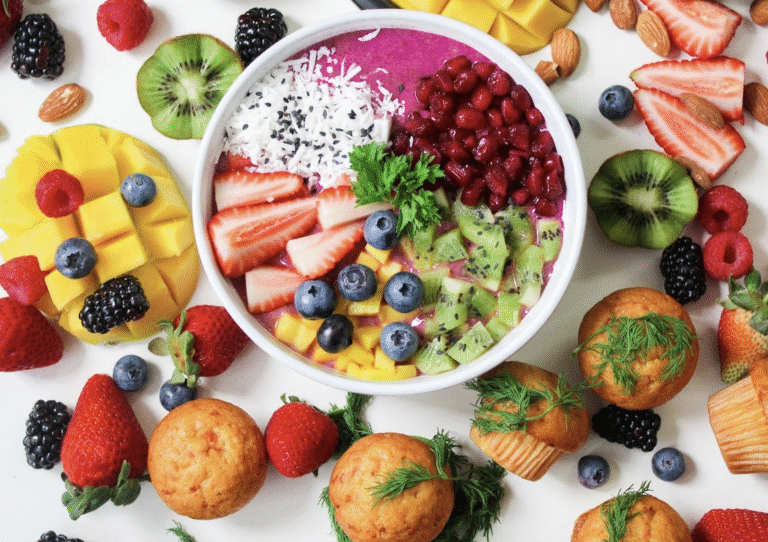How to build a better relationship with food, fuel your body effectively, and make sense of the science behind good nutrition.
Why Good Nutrition Matters
Most people know what they should eat — more vegetables, less junk, drink water — yet few understand why those choices matter or how food actually works inside the body.
Good nutrition isn’t about perfection or restriction. It’s about giving your body what it needs to perform, recover, and thrive — consistently.
This guide breaks nutrition down into clear principles, useful terminology, and practical truths you can apply right away.
1. The Core Principles of Good Nutrition
1️⃣ Balance
Your body runs on three macronutrients — carbohydrates, proteins, and fats. Each plays a different role:
- Carbs fuel your muscles and brain.
- Protein repairs tissue and builds strength.
- Fats regulate hormones and protect your organs.
A balanced plate includes a little of each, giving your body steady energy instead of peaks and crashes.
2️⃣ Quality Over Quantity
Calories matter, but where those calories come from matters more.
Whole, nutrient-dense foods — oats, eggs, legumes, vegetables — deliver vitamins, minerals, and fibre that your body can actually use.
Ultra-processed foods often deliver calories without nutrition, leaving you hungry again soon after.
3️⃣ Consistency Beats Perfection
Long-term results come from steady habits, not temporary diets.
Missing a meal or having dessert won’t undo progress — it’s the pattern that counts. Build habits you can maintain 80–90 percent of the time.
4️⃣ Hydration Supports Everything
Water drives digestion, nutrient transport, and focus.
A simple guideline is around 30 ml per kilogram of bodyweight per day — more in hot weather or during training.
5️⃣ Timing Matters (But Not Too Much)
You don’t need to eat every two hours, but spacing meals evenly through the day helps keep blood sugar and energy stable.
Think of nutrition as rhythm, not rigidity.
6️⃣ Nutrients Work in Teams
Food isn’t chemistry in isolation — nutrients interact.
Certain vitamins need fats to be absorbed; others rely on vitamin C or sunlight. Understanding these pairings turns good nutrition into great nutrition.

2. Understanding the Language of Nutrition
A few terms make the science much easier to follow.
| Term | Meaning | Quick Example |
|---|---|---|
| Macronutrients (Macros) | Nutrients that provide calories: carbs, protein, fat. | A 40/30/30 macro split (C/P/F) |
| Micronutrients | Vitamins and minerals needed in small amounts. | Iron, zinc, vitamin D |
| Calories (kcal) | A unit of energy. | 1 g protein = 4 kcal; 1 g fat = 9 kcal |
| Metabolism | How your body converts food into energy. | More muscle = higher metabolism |
| Basal Metabolic Rate (BMR) | Energy used at rest to sustain life. | Accounts for most of your daily burn |
| Calorie Deficit / Surplus | Eating below or above your maintenance level. | Deficit = fat loss; surplus = muscle gain |
| Whole Foods | Foods close to their natural form. | Vegetables, fruit, grains, eggs, nuts |
Learning these basics gives you control over your diet instead of relying on fads or guesswork.
3. Common Nutrition Myths (and the Truth Behind Them)
“Carbs make you fat.”
Only excess calories cause fat gain. Carbohydrates are your body’s main energy source and crucial for recovery.
“Fat is bad for you.”
Healthy fats — from olive oil, avocados, fish, and nuts — support hormones, joints, and brain function. They also make food satisfying.
“Protein damages your kidneys.”
For healthy people, this is false. Adequate protein helps maintain muscle, immunity, and fullness.
“Skipping meals helps you lose weight.”
In reality, skipping meals often slows metabolism and triggers overeating later. Controlled portions work better than deprivation.
“Healthy eating is expensive.”
Whole foods like rice, beans, eggs, and frozen vegetables are cheaper per meal than most takeaways or processed snacks.
4. The Truth About Fats and Nutrient Absorption
Fats: The Unsung Hero
For decades, fat was wrongly blamed for weight gain. In truth, fats are essential — they help build hormones, cushion organs, regulate temperature, and allow you to absorb vitamins that are otherwise wasted.
| Type | Found In | Benefit |
|---|---|---|
| Monounsaturated | Olive oil, avocado, nuts | Heart health, lowers bad cholesterol |
| Polyunsaturated (Omega-3 & 6) | Oily fish, flaxseeds, walnuts | Reduces inflammation, supports brain function |
| Saturated (limit, don’t fear) | Dairy, eggs, coconut | Energy and hormone production |
| Trans fats (avoid) | Fried foods, pastries | Increase inflammation and bad cholesterol |
Healthy fats should make up roughly 25–35 percent of total calories for most people.
How Fat Affects Nutrient Absorption
Some vitamins are fat-soluble, meaning your body can only absorb them if fat is present in the same meal.
| Vitamin | Role | Found In | Needs Fat From |
|---|---|---|---|
| A | Eye health, immunity | Carrots, kale, sweet potatoes | Olive oil, avocado |
| D | Bones, immune system | Oily fish, eggs, sunlight | Any healthy fat |
| E | Skin, antioxidant protection | Nuts, seeds, spinach | Avocado, nut butter |
| K | Blood clotting, bone strength | Leafy greens | Olive oil, eggs |
Example:
A salad of spinach, tomato, and carrot is nutrient-rich but low in fat — meaning vitamins A, E, and K pass through unused. Add a drizzle of olive oil or half an avocado, and absorption improves dramatically.
The “Mix It Right” Principle
Food synergy means certain nutrients amplify each other:
| Nutrient | Partner | Why It Works |
|---|---|---|
| Iron (spinach, beans) | Vitamin C (peppers, citrus) | Vitamin C increases iron absorption |
| Vitamin D | Healthy fats | Fat enables storage and uptake |
| Calcium (dairy, greens) | Vitamin D | Vitamin D moves calcium into bone tissue |
| Fat-soluble vitamins (A, D, E, K) | Healthy fats | Required for absorption |
When meals include colour, texture, and balance, your body can use what you eat far more effectively.
Practical Ways to Support Absorption
- Include a small portion of healthy fat with every meal — olive oil, nuts, seeds, or avocado.
- Combine bright vegetables with a fat source for full vitamin use.
- Add chia or flaxseeds to smoothies for better uptake of nutrients.
- Don’t fear dietary fat — fear imbalance.
5. Making Smart Fueling Choices
Good nutrition isn’t about perfection — it’s about patterns and awareness.
Use the “3 C’s” model as a mental checklist.
1️⃣ Choose
Prioritise foods that are natural, colourful, and minimally processed.
Ask yourself: Did this grow, swim, or run?
2️⃣ Combine
Build meals that include protein + complex carbs + healthy fat + colourful produce.
This balance fuels energy, recovery, and mental focus.
Example: salmon + potatoes + broccoli + olive oil.
3️⃣ Control
Be mindful of portion sizes and emotional eating.
A simple hand-guide works well:
- Palm = protein
- Fist = carbs
- Thumb = fat
- Two cupped hands = vegetables
Good vs. Best Fuel Choices
| Situation | ok | better |
|---|---|---|
| Breakfast | Cereal + milk | Oats + berries + Greek yoghurt |
| Lunch | Sandwich | Whole-grain wrap + chicken + salad |
| Snack | Chocolate bar | Banana + peanut butter |
| Drink | lemonade | water + lemon |
Small swaps like these make daily nutrition effortless and sustainable.
6. Key Takeaways
- Nutrition is about fuel, not restriction.
- Learn the basics: macros, micros, metabolism.
- The body thrives on balance, variety, and consistency.
- Healthy fats make good nutrition work better.
- Every small, repeated choice builds long-term health.
Final Thought
You don’t need to count every calorie or follow complex plans to eat well.
If you focus on balanced meals, consistent habits, and the simple truth that food is information for your body, you’ll already be miles ahead of most diets.
Good nutrition isn’t about eating less — it’s about eating smart.




